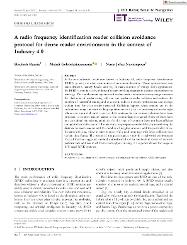| dc.contributor.author | Rezaie, Hadiseh | |
| dc.contributor.author | Golsorkhtabaramiri, Mehdi | |
| dc.contributor.author | Navimipour, Nima Jafari | |
| dc.date.accessioned | 2023-10-19T15:13:06Z | |
| dc.date.available | 2023-10-19T15:13:06Z | |
| dc.date.issued | 2023 | |
| dc.identifier.issn | 1751-8784 | |
| dc.identifier.issn | 1751-8792 | |
| dc.identifier.uri | https://doi.org/10.1049/rsn2.12346 | |
| dc.identifier.uri | https://hdl.handle.net/20.500.12469/5605 | |
| dc.description.abstract | In the new industrial revolution known as Industry 4.0, radio frequency identification (RFID) systems are a key component of automatic detection. These systems have two main elements, namely Reader and Tag. In many Internet of Things (IoT) applications, the RFID system is used with lots of readers working together in a dense environment to read tags. The simultaneous operation of readers with a common sensory range increases the likelihood of reader-to-tag collision and reader-to-reader collision and reduces the number of successful reading and as a result, reduces network performance and average waiting time for each reader increased. Collisions happen when readers are in the interference range and start reading tags simultaneously, so it is necessary to use the right solution to control channel access in these systems. So far, various solutions have been proposed to control readers' access to the communication channel. Some of them have not considered the existing standards for this type of system or have not been efficient enough to be used in the IoT. In this study, we propose a method that, by considering the distance between readers and the number of neighbourhoods, and the possibility of information sharing, allows readers to successfully read more tags with fewer collisions in a certain time frame. The results of the performance study in a real-world environment showed that the suggested method outperformed similar methods in terms of network performance and has much better throughput, making it a superior choice for usage in IoT-based RFID systems. | en_US |
| dc.language.iso | eng | en_US |
| dc.publisher | Wiley | en_US |
| dc.relation.ispartof | Iet Radar Sonar and Navigation | en_US |
| dc.rights | info:eu-repo/semantics/openAccess | en_US |
| dc.subject | Anticollision Protocol | En_Us |
| dc.subject | Energy-Consumption | En_Us |
| dc.subject | Algorithm | En_Us |
| dc.subject | Fair | En_Us |
| dc.subject | average waiting time | en_US |
| dc.subject | Industry 4 | en_US |
| dc.subject | 0 | en_US |
| dc.subject | reader-to-reader collision | en_US |
| dc.subject | reader-to-tag collision | en_US |
| dc.subject | RFID | en_US |
| dc.subject | throughput | en_US |
| dc.title | A radio frequency identification reader collision avoidance protocol for dense reader environments in the context of Industry 4.0 | en_US |
| dc.type | article | en_US |
| dc.identifier.startpage | 362 | en_US |
| dc.identifier.endpage | 373 | en_US |
| dc.authorid | Jafari Navimipour, Nima/0000-0002-5514-5536 | |
| dc.authorid | rezaie, hadiseh/0009-0009-6557-1537 | |
| dc.authorid | Golsorkhtabaramiri, Mehdi/0000-0002-9932-2477 | |
| dc.identifier.issue | 3 | en_US |
| dc.identifier.volume | 17 | en_US |
| dc.department | N/A | en_US |
| dc.identifier.wos | WOS:000878239500001 | en_US |
| dc.identifier.doi | 10.1049/rsn2.12346 | en_US |
| dc.identifier.scopus | 2-s2.0-85141368674 | en_US |
| dc.institutionauthor | N/A | |
| dc.relation.publicationcategory | Makale - Uluslararası Hakemli Dergi - Kurum Öğretim Elemanı | en_US |
| dc.authorwosid | Jafari Navimipour, Nima/AAF-5662-2021 | |
| dc.authorwosid | rezaie, hadiseh/HOI-0417-2023 | |
| dc.authorwosid | Golsorkhtabaramiri, Mehdi/T-8097-2018 | |
| dc.khas | 20231019-WoS | en_US |
















